
Our world is full of spectacular natural wonders.
Rushing rivers, underwater lakes, enormous dramatic rock formations in places like the Grand Canyon and Zion National Park, the Northern Lights, glaciers, caves…the list goes on and on.
Among those natural wonders, bioluminescent bays, where the sea itself appears to glow, are some of the most mystical and least-known. Commonly referred to as bio bays, there are only a handful of these magical places on Earth.
This post contains affiliate links. I may receive a small commission — at no cost to you — if you click or make a purchase through any of them. For more information, read my disclosure statement. I appreciate you!
Jump ahead to:
- What is a Bioluminescent Bay?
- How Many Bioluminescent Bays Are There in the World?
- Bioluminescent Bays in Puerto Rico
- Bioluminescent Bays in Mexico
- Bio Bays in the United States
- Other Bioluminescent Bay Locations
- Tips for Visiting Bioluminescent Bays
- What to Pack for Bioluminescent Kayaking
- Map of Bioluminescent Bays
What is a Bioluminescent Bay?

By definition, bioluminescence is “the production and emission of light by a living organism.” Fireflies, glow worms, and many types of jellyfish are all examples of bioluminescent organisms.
In terms of bioluminescent bays, a few specifics must be present for this emission of light to occur.
The first and most important is a high concentration of dinoflagellates, teeny-tiny, single-celled plankton.
When gently agitated — such as by a kayak paddle or ocean waves — dinoflagellates emit luciferin, a chemical that creates a bright glow when it combines with oxygen. The luciferin makes the microorganisms appear to sparkle underwater.
Other environmental conditions necessary for a bioluminescent bay include warm, shallow water, the presence of red mangroves, and being semi-enclosed from the open sea. This allows dinoflagellates to congregate and thrive in the bio bays.
Special note: Motor boats create pollution that can be extremely harmful to fragile bioluminescent bays. Consider choosing more eco-friendly options with lower impact, such as bioluminescent kayaking tours or simply visiting a beach with bioluminescent waves.
How Many Bioluminescent Bays Are There in the World?
When you research bioluminescent bays, you quickly realize that there’s a lot of conflicting information out there.
Many resources claim there are only five bio bays in the world, but we know that isn’t true — there are over 10 on this list alone!
While some bioluminescent bay locations are heavily guarded (we call this gatekeeping in the travel realm), there are about 20 in the world. Here, we explore the best bio bays you can actually visit, many of which offer bioluminescent kayaking tours.
Bioluminescent Bays in Puerto Rico
With several amazing options, bioluminescent bays in Puerto Rico are some of the world’s most beautiful and well-known.
1. Laguna Grande, Fajardo, Puerto Rico
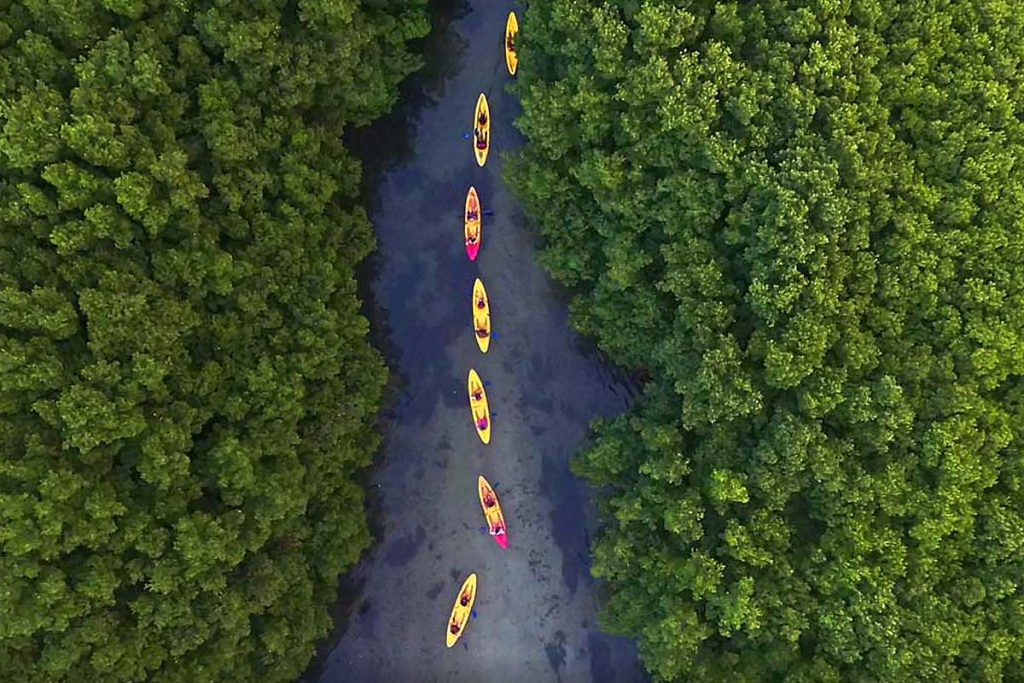
The Laguna Grande bioluminescent bay Puerto Rico is one of three on the island. Situated on the far northeastern tip near the town of Fajardo, Laguna Grande is the closest bio bay to San Juan, just a 45-minute drive.
This Puerto Rico bioluminescent bay is part of the Cabeza de San Juan Nature Reserve. To access it, you’ll paddle through a narrow canal lined with mangroves to Laguna Grande, which is partially protected by a coral reef.
Because of its circular lagoon shape, Laguna Grande is often called the “Puerto Rico glowing lake.”
One thing to note is that because Laguna Grande is the most easily accessible of Puerto Rico bioluminescent bays, it’s a wildly popular tourist attraction.
To be completely honest, I would only visit if you’re looking for a quick excursion from San Juan. The heavy tourism is affecting the bio bay and the bioluminescence is noticeably less bright. In fact, recent reviews indicate that tour guides put tarps over people’s heads to create more darkness.
If you have more time, consider going to one of the two other, less-visited Puerto Rico bioluminescent bays, listed below.
If you do visit Laguna Grande, understand that you will not have an intimate bioluminescent kayaking experience — numerous tours go out at once and you will share the bio bay with many others.
You can still have a great experience if you go into it with the right expectations.
Recommended Laguna Grande bioluminescent kayaking tour: 2-hour tour with Kayaking Puerto Rico
Other can’t-miss activities near Laguna Grande: Visit the observation deck at El Faro de Fajardo, the island’s oldest lighthouse, and get off the beaten path with a hike to La Zanja.
More top-rated things to do in Fajardo!
2. La Parguera, Lajas, Puerto Rico
Contributed by Dhara from It’s Not About the Miles

Located on the island’s southwestern coast near the town of Lajas, the small fishing village of La Parguera is home to one of three Puerto Rico bioluminescent bays.
A visit to La Parguera is a fantastic addition to a Puerto Rico itinerary that spans a few days. If you’re planning to visit from San Juan, the capital, it’s a two-hour drive each way, but it’s easier to visit independently from the city of Ponce.
Or, join a guided tour from San Juan for a hassle-free visit!
La Parguera Nature Reserve is home to a beautiful coral reef and is considered to be one of the most biologically diverse ecosystems on the island, with mangroves, sea turtles, and more.
Although you won’t find beaches at La Parguera, it’s blessed with beautiful cays. You can rent a boat and explore the cays on your own or find a local company to take you on a guided tour.
Plus, it’s less than 30 minutes away from gorgeous beaches and some of the best Puerto Rico resorts for families.
One of La Parguera’s top attractions is undoubtedly its bio bay. Unlike the other two Puerto Rico bioluminescent bays, La Parguera allows you to swim in the shimmering waters, so don’t forget to pack your swimsuit!
A 25-minute boat ride after sunset takes you through scenic mangrove reserves to the bio bay. When you swim, the action disturbs the water, precipitating the shimmery phenomenon. You’ll spend about 30-40 minutes in the bay before taking the boat back.
Recommended La Parguera bioluminescent kayaking tour: A small group tour from San Juan or the local snorkeling tour from Paradise Scuba & Snorkeling
Other can’t-miss activities in La Parguera: Take a boat out to Cayo Enrique and go snorkeling or scuba diving to observe the variety of marine life.
3. Mosquito Bay, Vieques Island, Puerto Rico
Contributed by Daria from The Discovery Nut
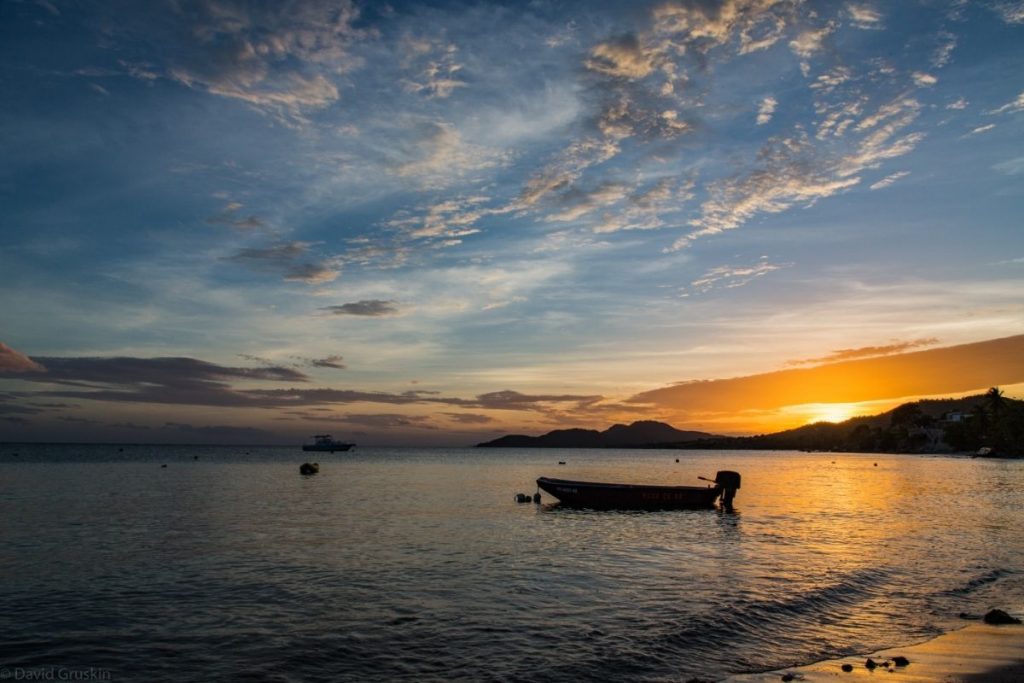
Located on the southern shore of Vieques Island, Puerto Mosquito (Mosquito Bay) is often called one of the best things to do in Puerto Rico. It’s said to be the most beautiful bioluminescent bay in the world!
One of many fun facts about Puerto Rico is that Mosquito Bay’s waters are home to a particularly high concentration of Pyrodinium bahamense. This specific type of dinoflagellates create the amazingly bright, natural bioluminescence.
When the “dinos” are shaken or come into contact with another organism, they produce a burst of bright blue light.
The Guinness Book of World Records named Mosquito Bay Puerto Rico the brightest bioluminescent bay in the world in 2008. Although it was damaged by Hurricane Maria in 2018, Mosquito Bay has since recovered and continues to be one of the most visited places on Vieques.
Visiting this bioluminescent bay is only possible with a tour, which you can easily book ahead of your Vieques trip. To get to the island, you can take a quick flight from the capital city San Jose or take a boat, which is cheaper but takes longer.
Recommended Vieques bioluminescent kayaking tour: The private glass-bottom boat tours from Vieques Kayaks Bio Bay
Other can’t-miss activities near Mosquito Bay: Other than the bio bay, make sure to visit Vieques National Wildlife Refuge, one of the most diverse refuges in the Caribbean, with gorgeous views and incredible wildlife.
Check out these Vieques Puerto Rico bio bay tours!
Bioluminescent Bays in Mexico
As you’re about to learn Mexico’s bio bays are some of the most unique in the world. That’s because, for one, they’re not technically bio bays—they’re bioluminescent lagoons and beaches, one of the best things to do in Holbox.
4. Isla Holbox, Quintana Roo, Mexico
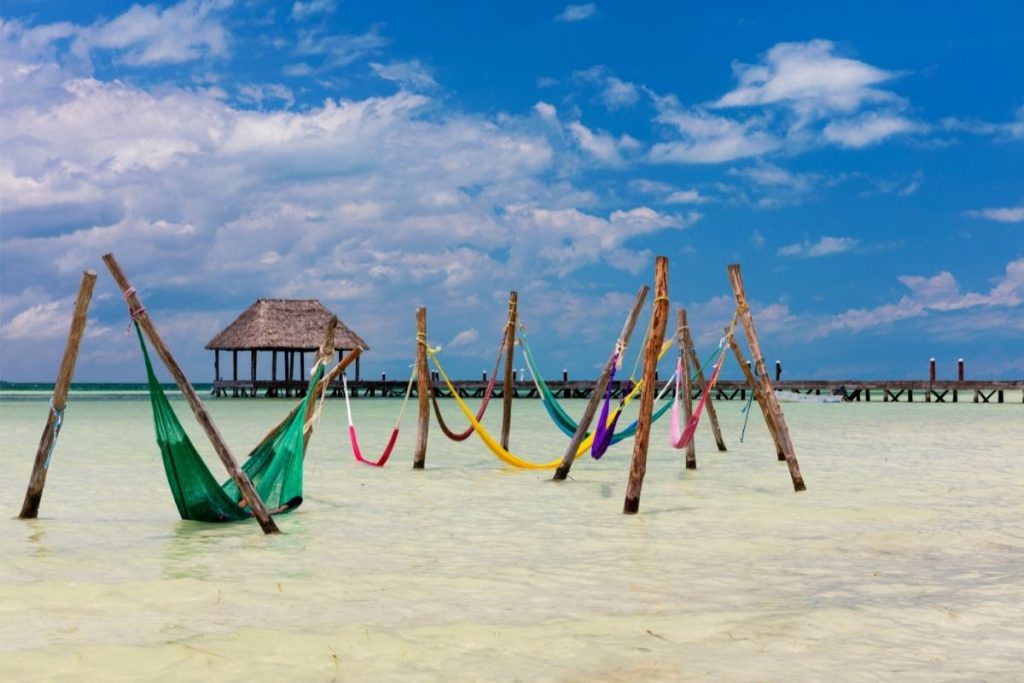
Technically not a bioluminescent bay, Isla Holbox is a tiny, tranquil island in the northern part of the Yucatan Peninsula, just a couple of hours from the bustling luxury and party resorts in Cancun. Here in Holbox, you’ll find bioluminescent beaches.
A warm, shallow lagoon separates Isla Holbox from the mainland, creating the perfect conditions for bioluminescent waves to wash up right on the shore!
You can often see bioluminescence as you stroll along beaches at night, but one of the best places to experience it is Punta Cocos Beach on the southernmost point of Isla Holbox. Simply watch the waves come in and glow as they hit the shore, or get in the water and splash around!
Best of all, this small fishing island is not a well-known tourist destination. You won’t find crowds on Isla Holbox and there’s practically no light pollution. In fact, vehicles aren’t allowed at all!
Visitors must take a ferry from Chiquila, on the mainland. Boat travel from Isla Mujeres to Holbox is also popular, allowing you to experience TWO stunning island gems.
Other can’t-miss activities on Isla Holbox: Get to Punta Cocos Beach before sunset and lounge in the hammocks that hang partially in the water!
Looking for other things to do on Isla Holbox?
5. Manialtepec Lagoon, Puerto Escondido, Mexico
Contributed by Julien Casanova of Cultures Traveled

Located near Puerto Escondido in the southern state of Oaxaca, the dense mangroves of Manialtepec Lagoon are home to a variety of bird species. It’s also one of the top bioluminescent bays in Mexico.
During the new moon phase, small boats take groups across the lagoon to swim and stir up the bioluminescent organisms. Since it’s just a 20-minute drive northwest of Puerto Escondido, Manialtepec Lagoon is easily accessible by car, taxi, colectivo, or many tours.
The proximity to the city also means you can plan a day of other activities and still have time to experience the bio bay at night.
Puerto Escondido itself is one of the top surfing destinations along the Oaxacan coast. And if you aren’t into surfing, there are tons of other fun things to do in Puerto Escondido. Activities include whale-watching, releasing turtles on the beach, and day trips into the nearby mountains.
Recommended bio bay tour in Manialtepec Lagoon: Eco Adventures Puerto Escondido’s bioluminescent bay boat ride and swimming tour
Other can’t-miss activities in Puerto Escondido: Go whale-watching!
Check out Puerto Escondido bio bay tours and other top activities!
Bio Bays in the United States
6. San Diego, California
Contributed by Taylor from Nomads in Nature

One of the rarest and most stunning bioluminescent bays in the world is located in San Diego, CA.
There’s a catch, though — you can only see San Diego bioluminescence a few days to a week out of an entire year, and the exact dates vary. As you can imagine, getting the timing right is tricky.
The most common time of year to see San Diego’s bio bay light up is during summer or spring.
The glowing tide phenomena, which is actually “red tide,” is caused by a sudden algae bloom. When disturbed (by a predator or a wave full of plankton), the algae reacts with oxygen and creates a bright blue glow.
One of the best bio bays in San Diego to watch the glowing tide is Torrey Pines State Beach near La Jolla. It has some of the lowest light pollution in San Diego and the most ideal time to see bioluminescence occur is a couple of hours after sunset in the breaking waves.
Torrey Pines State Beach is easily accessible off the major freeway through town. If you’re going, make an evening of it and hike Torrey Pines Trail, one of San Diego’s most beautiful and scenic hikes.
Recommended bioluminescent kayaking tour in San Diego: There aren’t any specifically since the occurrence of San Diego bioluminescence is so rare, but I do love the sea cave kayak tours in La Jolla!
Many outfitters offer bio bay kayaking tours, but you have to keep an eye on individual companies’ socials to know when that happens.
Other can’t-miss activities in San Diego: Watch the sunset from one of these 8 stunning sunset spots in San Diego
Check out these top-rated La Jolla sea cave kayak tours!
7. Space Coast, Florida

Perhaps one of the least-known locations with bioluminescent bays anywhere (bet you didn’t know the Sunshine State has bio bays, right?!), Florida’s Space Coast is paradise for nature lovers.
Located in Brevard County about one hour from Orlando, the Space Coast is home to a whopping three bio bays: Indian River Lagoon (which technically comprises three individual waterways — the Indian River, Banana River, and Mosquito Lagoon), Merritt Island Wildlife Refuge, and Cocoa Beach.
The area’s year-round warmth and humidity, combined with high levels of salt in the water, make ideal conditions for dinoflagellates — especially in the summer (bring bug spray!).
Here are some suggestions for the best places to experience bioluminescent kayaking in each of these Florida bio bays:
- Cocoa Beach: The undeveloped Banana River Aquatic Preserve
- Indian River Lagoon: Mosquito Lagoon
- Merritt Island Wildlife Refuge: Haulover Canal, smack in the middle of the refuge with zero light pollution
Because of the unique geography and easy accessibility of Florida’s bio bays, you can actually explore them on your own. Invest in an inflatable kayak, then alternate exploring the nearby beaches and lagoons with paddling through the water.
Thanks to Florida’s incredible biodiversity, you may even see dolphins or manatees during your bioluminescent kayaking excursion. Imagine a “glowing” dolphin speeding by in the dark!
Recommended Florida bioluminescent kayaking tours:
- BK Adventures – Super small group tours on the Banana River in Merritt Island Wildlife Refuge
- Florida Adventurer – 90-minute tours in either Haulover Canal or Kiwanis Island Park on Merritt Island
- A Day Away Kayak Tours – The original bioluminescent kayaking excursions in Florida, A Day Away offers a variety of tours in varying Space Coast locations throughout the year
8. Salt River Bay, St. Croix, US Virgin Islands

St. Croix is truly an underrated gem in the US Virgin Islands. It’s much less developed than nearby St. Thomas, which means visitors enjoy a distinct lack of crowds, more affordable prices, and a more authentic Caribbean island experience.
Because of all these things, St. Croix is also one of the safest Caribbean Islands to visit.
There are also a ton of outdoor adventures on St. Croix, including an underwater national park, Buck Island Reef National Monument.
One of the island’s most impressive features is the Salt River Bay National Historical Park and Ecological Preserve, one of two St. Croix bioluminescent bays. The other is Altona Lagoon, but it’s not easily accessible.
Somewhat unique to St. Croix, Salt River Bay is home to bioluminescent comb jelly fish in addition to the more common dinoflagellates.
Comb jellies have a more pronounced glow, making this bio bay especially bright. Our guide actually (very carefully!) handled one of them to let us see it up close!
St. Croix is MUCH less touristy than others in the Caribbean, so bio bay tours are noticeably more low-key. Your guide will lead you into the bioluminescent bay, then let you have time to explore it on your own. Be sure to reach into the water and marvel at the “stars!”
Recommended bioluminescent kayaking tour in St. Croix: Bush Tribe Eco Adventures Bioluminescent Kayaking Trip
Other can’t-miss activities on St. Croix: Hike to the Annaly Bay tide pools, visit the beer-drinking pigs at the Mt. Pellier Hut Domino Club, and snorkel off the shore in Frederiksted.
Here are some other top things to do on St. Croix!
Other Bioluminescent Bay Locations
9. Punta Cuchillos, Costa Rica
Contributed by Annick from The Common Traveler
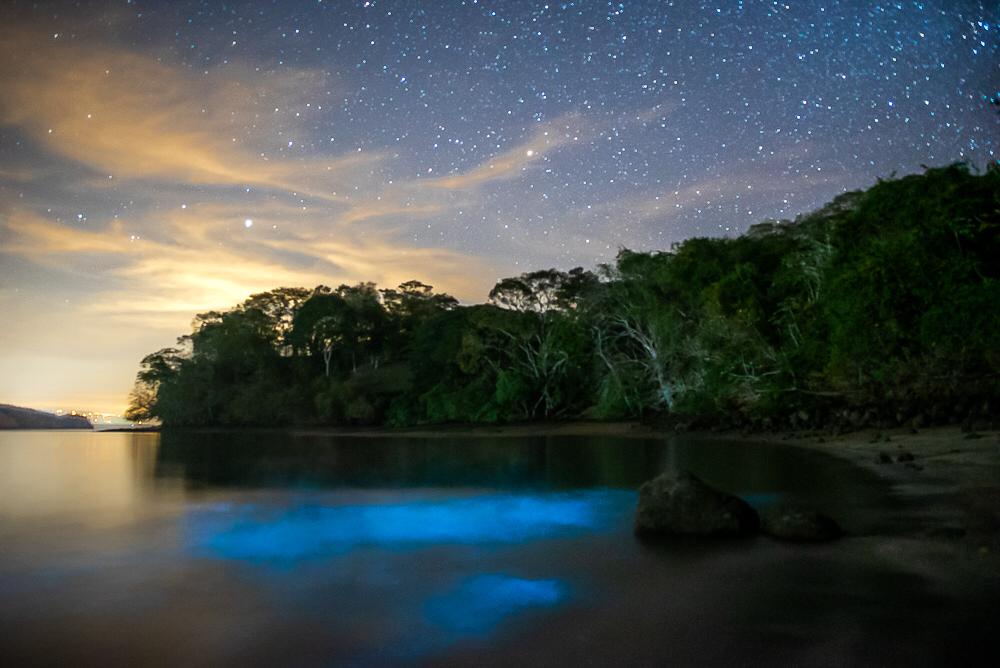
One of the world’s least known bioluminescent bays can be found at Punta Cuchillos. A visit here should be part of any Costa Rica itinerary, as the water truly sparkles most nights.
Punta Cuchillos bioluminescence is permanent, meaning it occurs naturally year-round. This is an even rarer phenomenon!
You can easily reach Punta Cuchillos by taking the ferry from Punta Arenas to Paquera. This is the easiest way if you’re flying into San Jose.
You can also drive to Punta Cuchillos from the airport in Liberia, but note that it is located at the southern end of the Nicoya Peninsula. This makes for a long and at times torturous drive!
Wishing to stay nearby so you don’t have to drive dangerous roads at night? Consider spending the night (or weekend!) at the fabulous Isla Chiquita Glamping Hotel, which also offers Punta Cuchillos bioluminescent bay tours.
Recommended bioluminescent kayaking tour in Punta Cuchillos: Bahia Rica Adventures (extremely kid-friendly, too!)
Other can’t-miss activities in Punta Cuchillos: Whale- and dolphin-watching, chasing Costa Rica waterfalls, and taking a boat tour to Isla Tortuga. This island has white-sand beaches and turquoise waters for snorkeling and sunning.
Sarah from Costa Rica Vibes (who has lived in Costa Rica for several years!) also recommends visiting the nearby Curu Reserve, a wildlife reserve with tons of different trails and a beautiful beach, and taking a boat tour to Isla San Lucas, an old prison on an island that is now a national park.
10. Luminous Lagoon, Jamaica
Contributed by Isabella from Boundlessroads.com
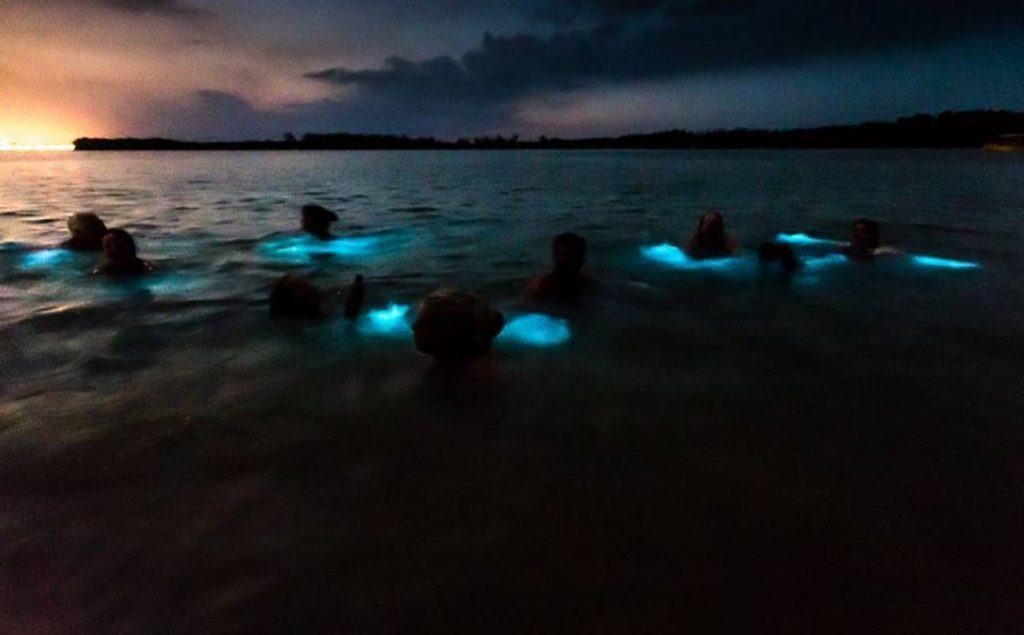
Check out these top Luminous Lagoon Jamaica bio bay tours!
11. Koh Phi Phi, Thailand
Contributed by Chris from More Life in Your Days

Koh Phi Phi in the Krabi province of Thailand is surely one of the most beautiful islands on the planet. The beauty is not only found above the water, though — Koh Phi Phi is also a great place for snorkeling, diving, and seeing the bioluminescent bay.
Thailand has a few bioluminescent bays where you can witness the amazing spectacle of glowing plankton. By far the most famous is Maya Bay on the smaller, uninhabited island of Koh Phi Phi Leh.
This is where Leonardo DeCaprio filmed The Beach and it’s an absolutely spectacular destination that you can visit on special bioluminescence tours from the main Phi Phi Don island.
A Koh Phi Phi bio bay tour can be done as a short evening affair or as the finale to an entire day of visiting various sites. Kayaking is one of the best ways to explore the island. These tours can easily be arranged once you get to Koh Phi Phi.
Special note: Maya Bay is periodically closed to protect it from environmental degradation caused by the huge numbers of tourists that visit. If this happens during your trip, there are other places you can see bioluminescent bays, like Bamboo island.
Recommended bio bay tour in Koh Phi Phi: Oh-Hoo’s 7 Islands Snorkeling Sunset and Bioluminescence Tour, which includes a buffet dinner.
Other can’t-miss activities in Koh Phi Phi: Hike up to the unimaginatively named Viewpoint 3, where you get amazing views of the island and sea.
12. Cat Ba Island, Ha Long Bay, Vietnam
Contributed by Steph from A Nomad’s Passport
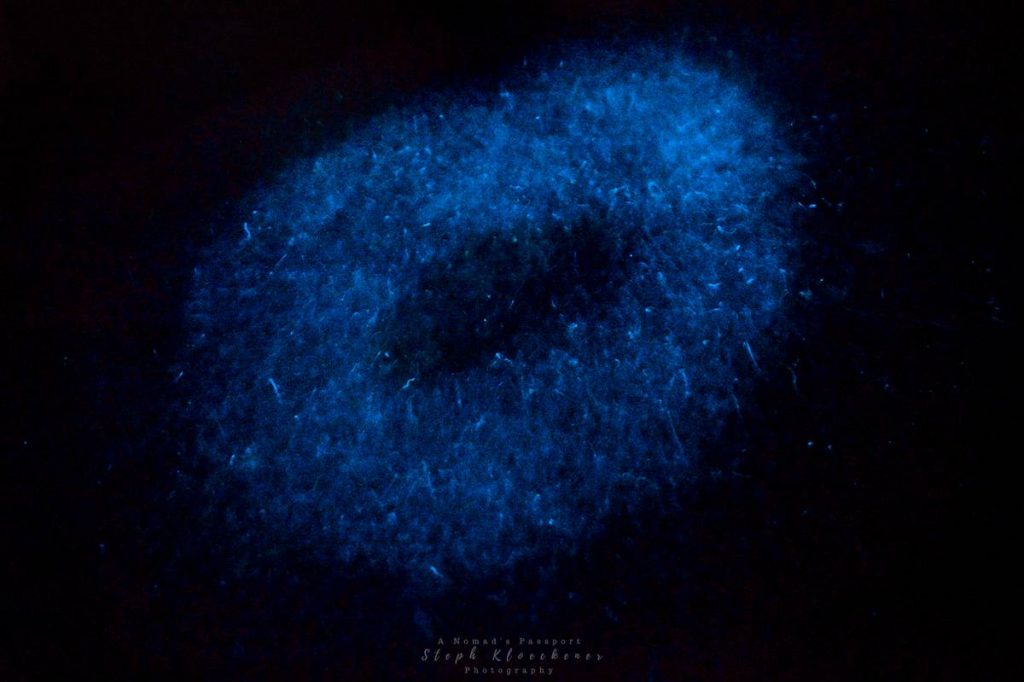
With their unique limestone formations, Halong Bay and Lan Ha Bay off the coast of northern Vietnam are more than worthy bucket list destinations. Better yet, it’s easy to get from bustling Hanoi to Halong Bay!
Few know, though, that one of their wonders is only visible at night. After all, some areas of this UNESCO World Heritage Site are bioluminescent bays, which makes them perfect to visit during a new moon.
The best and easiest way to see and swim in this sea of stars is to visit Cat Ba Island.
Four of the island’s southern beaches are ideal to see the bioluminescence, and ‘Hair of the Dog Beach’ (Tung Thu Beach in Vietnamese) is the best one.
It’s framed by towering limestone formations that block out artificial light, which makes it the best and most accessible bio bay in the area.
Take the ferry or cable car to Cat Ba Island and then walk to one of the four beaches once night falls. Locals will tell you the best time to go to the beach.
Note: Nighttime beach and water access is heavily restricted in Ha Long Bay, so there are no official bio bay tours. Wait until late night when cruises have come in and artificial light is reduced, then head to a secluded area of Hair of the Dog Beach to experience the bioluminescent bay.
Other can’t miss activities in Ha Long Bay: A day cruise through this unique area and hiking Dinh Ngu Lam Peak on Cat Ba Island.
Tips for Visiting Bioluminescent Bays
- Pay attention to the moon cycle. The best time to see bioluminescence is when it’s extremely dark, so you want a night with little to no moon. If possible, plan your bio bay tour for a new moon phase.
- Understand that nearly all photos online of bio bays are Photoshopped or doctored in some way. Bioluminescence is incredibly hard to capture in photography because it lasts for just a (literal) second. It’s absolutely spectacular in person, to the naked eye, but realize that your bio bay photos likely won’t look anything like what you find online.
- Skip the hygiene products and opt for DEET-free bug spray. Even “clean” products can leave behind residue that’s harmful to dinoflagellates when you make contact with the water.
- Stay close to your guide if you want some education. Bioluminescent kayaking tours often give participants the chance to explore on their own. If you want to learn about the marine life or get tips on what to look for in the bio bay, stick with your guide.
- Bring cash to tip! This is, sadly, often overlooked when going on guided tours in bioluminescent bays. Your guide works hard to give you an unforgettable experience. 15-20% is recommended.
What to Pack for Bioluminescent Kayaking

Map of Bioluminescent Bays
Well, there you have it — the world’s most amazing bioluminescent bays! Have you visited any of them, or are any on your travel bucket list?
WANT MORE WATER-FOCUSED CONTENT?
- Where to Kayak With Manatees in Florida
- The Best Inflatable Kayaks
- White Water Rafting in Yellowstone National Park
- How to Kayak Horseshoe Bend
- Scenic Float Trips in Grand Teton National Park
Don’t forget to pin this post for planning your bioluminescent kayaking trip later!
Sharing is caring!
Taryn
Taryn is happiest when she's outside and always up for an adventure — especially if it involves a hike, sunset, road trip, or limited cell service.

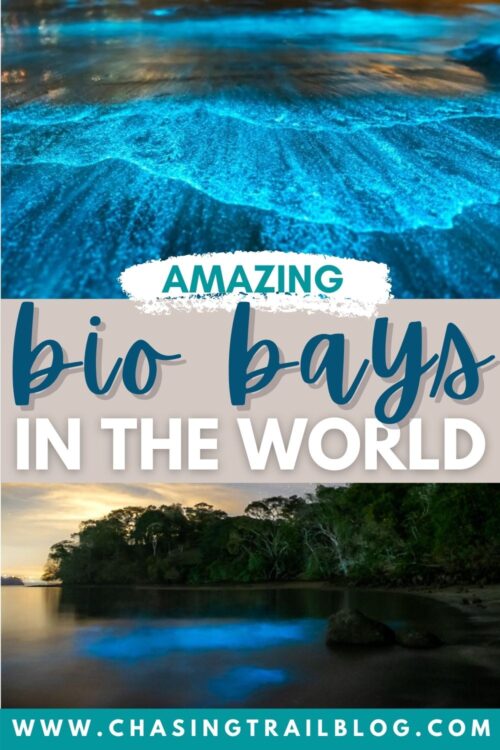
Irich photography
Well explained blog